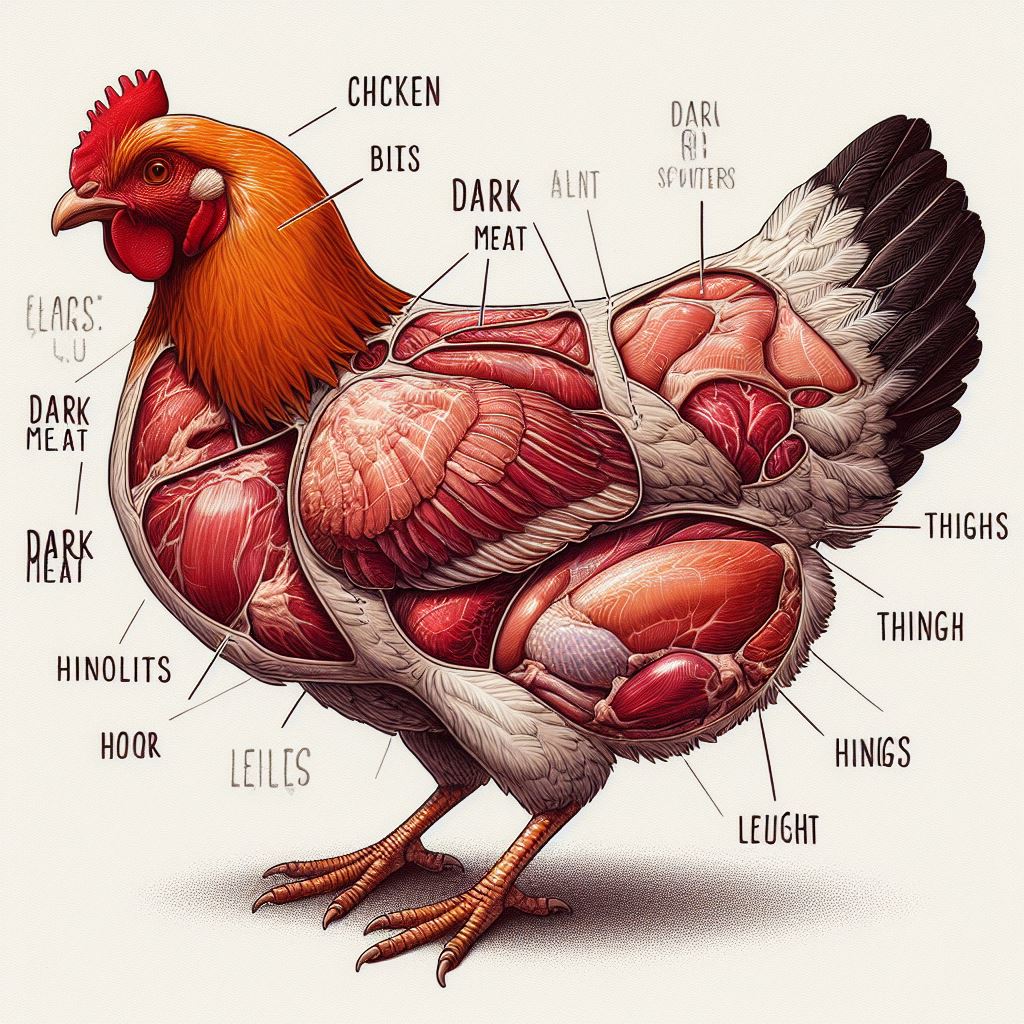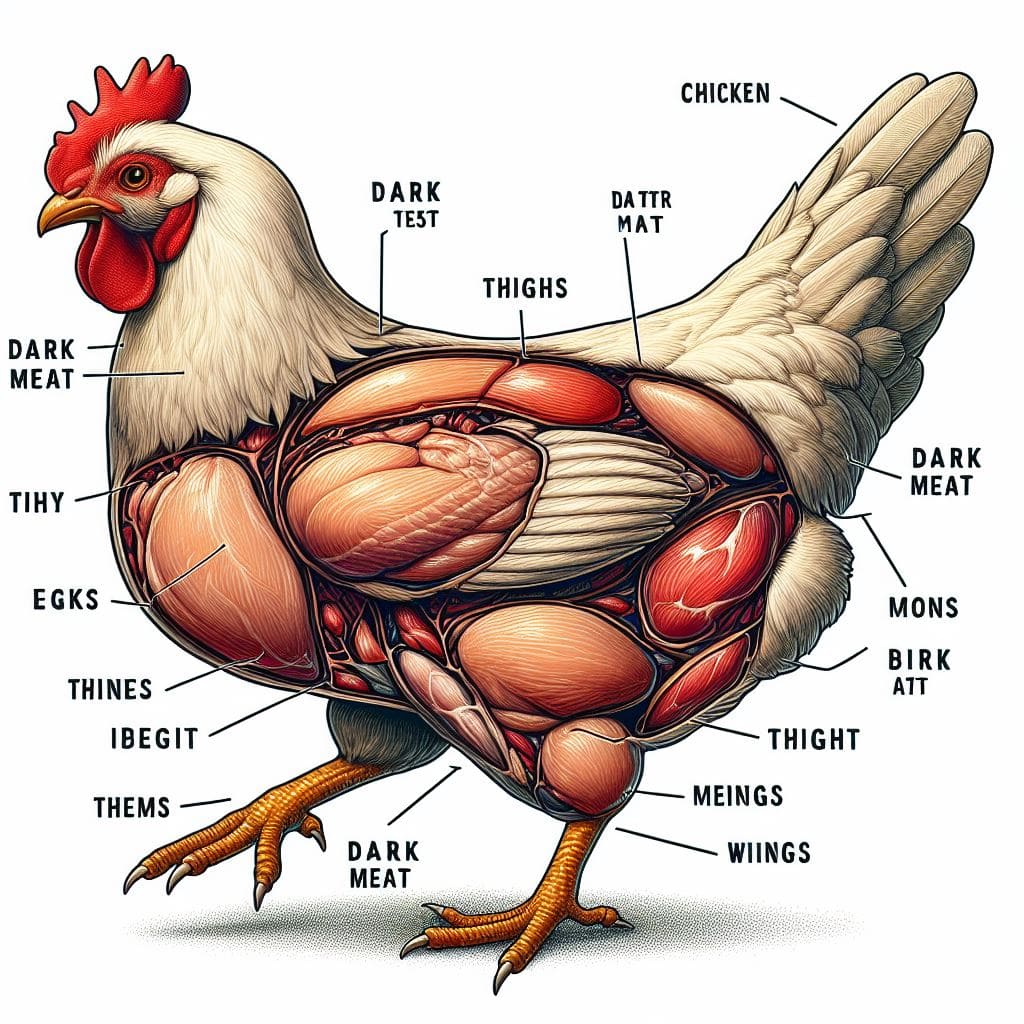Dark meat in chicken originates from its legs, including the thighs and drumsticks. This meat appears darker due to higher myoglobin levels.
Understanding the different parts of chicken and their culinary characteristics can enhance meal planning and cooking experiences. Dark meat, found in the legs of the chicken, is known for its rich flavor and tender texture. Higher in fat and myoglobin than white meat, dark meat retains moisture well, making it a favorite for slow-cooking methods.
This part of the chicken is nutritious, providing an excellent source of protein, essential amino acids, and various vitamins and minerals. Due to its robust taste and juicy consistency, dark meat is a preferred choice in many cuisines worldwide, effortlessly absorbing spices and marinades to create savory dishes that satisfy the palate. Selecting dark meat can also be a cost-effective option, often priced lower than its white meat counterpart, while still offering substantial nourishment and taste.

Introduction To Chicken Meat
Chicken meat is a staple in cuisines around the globe, beloved for its versatility and nutritional benefits. From the bustling streets of Southeast Asia to the classic American dinner table, chicken serves as a centerpiece for countless dishes. In exploring this popular poultry, one often encounters a choice between white meat and dark meat. But what exactly differentiates these two types of meat? The answer lies deep within the anatomy of the chicken and has significant implications for both flavor and health.
Understanding Chicken Anatomy
Chicken anatomy reveals a fascinating dichotomy in muscle usage and meat texture. Chickens, being flightless birds, rely heavily on their legs and thighs for locomotion. The muscles in these parts are used more frequently, which leads to the development of meat that is richer in color and has a higher myoglobin content. This is where dark meat originates. In contrast, the breast and wings are composed of muscles that are less utilized, resulting in lighter, more tender white meat.
Contrast Between White Meat And Dark Meat
The distinction between white meat and dark meat is more than just skin deep. White meat, primarily found in the breast and wings, is known for its lower fat content and mild flavor, making it a favorite for health-conscious individuals. On the other hand, dark meat, which includes the legs and thighs, is characterized by its richer taste and juicier texture due to its higher fat and myoglobin content.
| White Meat | Dark Meat |
|---|---|
| Lower Fat | Higher Fat |
| Milder Flavor | Richer Flavor |
| Less Myoglobin | More Myoglobin |
| Tender Texture | Juicy Texture |
Nutritional Overview Of Chicken Meat Varieties
When it comes to nutrition, chicken meat varieties offer a wide spectrum of vitamins and minerals. White meat is often lauded for its high protein and low-calorie profile, attracting athletes and those on calorie-restricted diets. Conversely, dark meat provides a richer source of iron, zinc, and B vitamins, which are pivotal for energy production and a healthy immune system. The following points encapsulate the nutritional essence of chicken meat varieties:
- High-Protein Content: Both white and dark meat are excellent sources of complete protein.
- Fat and Calorie Differences: White meat is generally lower in fat and calories compared to dark meat.
- Vitamins and Minerals: Dark meat often contains more iron, zinc, and B vitamins than white meat.
- Versatility in the Kitchen: The unique properties of each type of meat provide a multitude of culinary options.
Identifying Dark Meat In Poultry
When you carve into a succulent piece of chicken, you may notice that not all meat looks or tastes the same. Understanding the characteristics of dark meat can greatly enhance your culinary experiences and nutritional knowledge. Let’s delve into the world of poultry, highlighting the unique attributes that distinguish dark meat from its lighter counterpart.
Location On The Chicken: Thighs And Drumsticks
The most straightforward way to identify dark meat on a chicken is by its location. Dark meat is found primarily in the thighs and drumsticks, which are the lower parts of the chicken’s legs. These areas engage in more activity, which leads to muscle differences when compared to the rest of the bird.
Appearance And Texture Differences
Dark meat stands out from white meat due to its distinct richer color and denser texture. You will notice that dark meat has a deeper, somewhat reddish hue as opposed to the pale, creamy color of breast meat. Upon tasting, dark meat feels juicier and more tender, which is a direct result of the muscle’s high fat content and the type of fibers it contains.
Why Dark Meat Is Dark: Myoglobin Content
The mystery behind the darkness of dark meat lies in a protein called myoglobin. Muscles that are used more frequently, like those in chicken thighs and drumsticks, store more myoglobin, which carries and stores oxygen in muscle cells. This oxygen-rich protein is what gives dark meat its characteristic color and contributes to its moist, flavorful nature when cooked.
| Location | Appearance | Texture | Myoglobin Content |
|---|---|---|---|
| Thighs, Drumsticks | Darker, reddish hue | Juicy, tender | High |
Culinary Aspects Of Dark Meat
When exploring the palette of poultry, dark meat stands out for its rich, nuanced flavors and silky texture. Sourced from the muscled parts of the chicken such as thighs and drumsticks, dark meat holds a reputation for its culinary versatility and robust taste. In this deep dive into the culinary world, we’ll uncover why dark meat is a favored choice for many cooks and food enthusiasts alike.
Flavor Profile Of Dark Meat
Dark meat, known for its deeper, more intense flavor, owes its unique taste to a higher fat content and myoglobin level compared to white meat. This part of the chicken is especially rich, carrying a savory umami character that makes it a standout in various dishes.
Cooking Techniques For Optimal Taste And Texture
- Slow Cooking: A lower and slower approach allows dark meat to tenderize over time, locking in moisture and elevating the inherent flavors.
- Marinating: Dark meat benefits greatly from marination, absorbing herbs and spices that enhance its natural taste profile.
- Grilling or Searing: Applying high heat creates a delectable crust on the exterior while preserving the tender, juicy interior.
- Braising: This method combines slow cooking with moisture, transforming dark meat into fall-off-the-bone delicacies.

Popular Dishes Highlighting Dark Meat
| Dish | Description |
|---|---|
| Coq au Vin | French classic that slowly simmers chicken in red wine, typically featuring succulent thighs and legs. |
| Chicken Cacciatore | Italy’s rustic stew where dark meat is braised with tomatoes, bell peppers, and onions for a hearty meal. |
| Jerk Chicken | Caribbean favorite where the rich taste of dark meat is paired with spicy, aromatic jerk seasoning, then grilled to perfection. |
| Chicken Tikka Masala | Indian-inspired dish featuring chunks of marinated dark meat in a creamy, spiced tomato sauce. |
Nutritional And Health Considerations
Nutritional and Health Considerations of chicken often center on the choice between white and dark meat. Read on to understand the differences in nutritional content and the potential health benefits that dark meat has to offer. Making informed choices about the parts of chicken you consume can impact your overall dietary health.
Nutritional Content Of Dark Meat Compared To White Meat
Dark meat, which is found in the legs and thighs of chicken, is distinguishable from white meat by its richer color, attributed to a higher content of myoglobin, a protein that delivers oxygen to muscles. But what does this mean nutritionally? Here’s a comparison:
| Nutrient | Dark Meat (100g) | White Meat (100g) |
|---|---|---|
| Calories | 173 | 165 |
| Fat | 9.7g | 3.6g |
| Protein | 20.6g | 31g |
| Vitamins & Minerals | Zinc, Vitamin B12, Iron, Niacin | Fewer vitamins & minerals |
Dark meat generally contains more calories and fat compared to white meat but also boasts a richer array of nutrients such as zinc and Vitamin B12.
Health Benefits Of Dark Meat Consumption
Eating dark meat chicken as part of a balanced diet can offer several health benefits:
- Sustained Energy: The iron content in dark meat can help in preventing anemia and maintaining energy levels.
- Muscle Growth: It provides high-quality protein essential for muscle repair and growth.
- Boosts Brain Health: Nutrients like Vitamin B12 in dark meat are vital for brain health and maintaining cognitive functions.
- Immune Support: Zinc plays an important role in supporting the body’s immune system.
These nutrients contribute collectively to overall health, enhancing both the immune system and daily energy levels.
Dietary Recommendations And Moderate Consumption
While dark meat is nutritious, it’s important to consider it within the context of your entire diet. The 2015-2020 Dietary Guidelines for Americans suggest varying protein sources and preparing them in healthy ways—baking, broiling, or grilling rather than frying. Also, consuming skinless chicken can significantly reduce calorie and fat intake.
- Limit the intake of saturated fats (less than 10% of daily calories).
- Include a variety of protein sources in the diet, such as seafood, lean meats, poultry, eggs, legumes, nuts, seeds, and soy products.
- For those who consume meat, incorporating a mix of white and dark meat can provide balanced nutrition.
Adopting a practice of moderate consumption is key to benefiting from dark meat’s nutritional value without overconsumption of calories and fats.

Conclusion
Understanding chicken’s dark meat has unveiled its nutritional benefits and unique flavor profile. Thighs and drumsticks are the go-to for those savory dishes we love. Remember, dark meat offers more than just a richer taste—it’s a powerhouse of vitamins and minerals.
So next time you’re at the poultry aisle, consider the hearty option of dark meat.
Frequently Asked Questions Of What Part Of Chicken Is Dark Meat
Which Chicken Cuts Are Considered Dark Meat?
Dark meat from chicken is found in the thighs and drumsticks. These parts get their darker color from more myoglobin in the muscle, which is used more during the chicken’s life.
Why Does Dark Meat Taste Different From White Meat?
Dark meat tastes richer than white meat due to higher fat content and myoglobin that affect flavor and moisture. More use of these muscles contributes to a stronger taste and juicier texture.
Is Dark Meat Higher In Nutrients Than White Meat?
Yes, dark meat is generally higher in nutrients than white meat, containing more vitamins, such as B-vitamins, and minerals like iron and zinc, owing to its different muscle structure and usage.
Can Dark Meat Be Considered Healthy?
Dark meat is healthy when eaten in moderation, as it contains more fat but also essential nutrients. Balancing diet and portion sizes will optimize health benefits while managing calorie intake.







